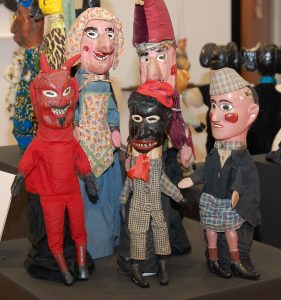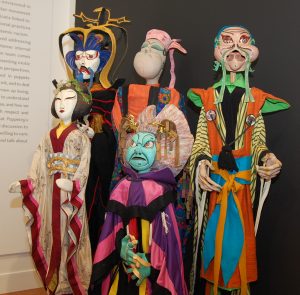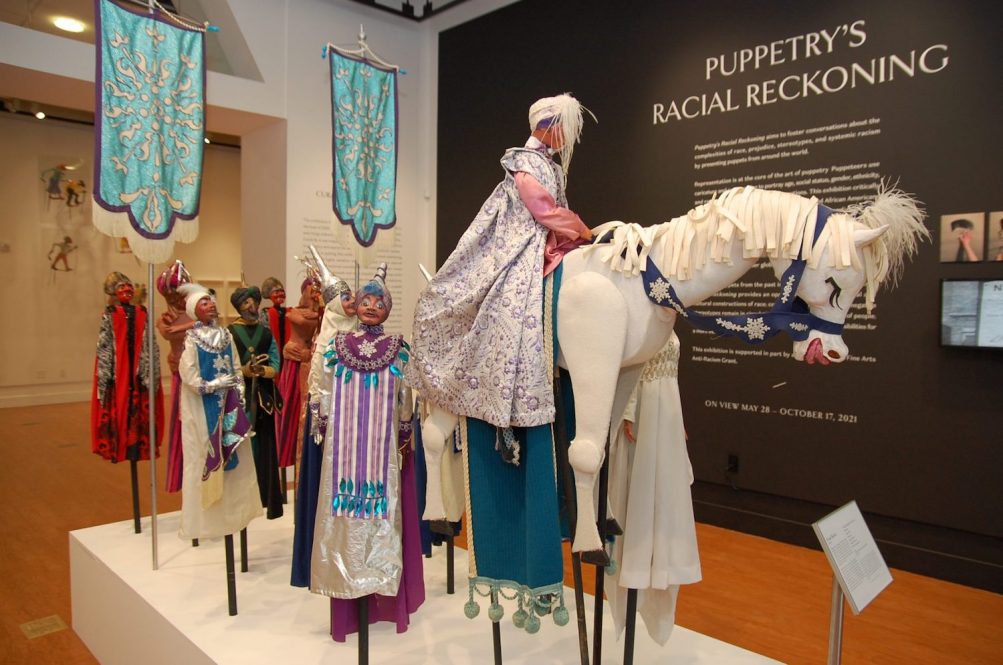Regular visitors to the Ballard Institute & Museum of Puppetry (BIMP), its Forum Series and Puppet Slams conducted with the UConn Puppet Arts Program understand the deep history of puppetry as a centuries-old form of storytelling that may include children’s entertainment, but is more often part of ritual ceremonies, thoughtful adult theatrical performances, political protest and reflections of worldwide culture.
“Puppetry’s Racial Reckoning,” the current BIMP exhibition, demonstrates that puppetry is also a forum to address contemporary issues by helping to foster conversation and understanding about the complexities of race, prejudice, stereotypes, and systemic racism.
“It was imperative to examine representational practices in puppetry and search for ways to reckon with systemic racism,” says Jungmin Song, a London-based performance artist, in her curator’s statement for the exhibit. “It was difficult to confront stereotypes embedded in puppets created by puppeteers admired for their artistry and wit, and to deal with racism in puppet characters many people have grown up loving. It is my hope that ‘Puppetry’s Racial Reckoning’ might extend our tough but fruitful discussions to the public and to open up a space for people who are willing to care for each other to learn and confront past injustices and talk about what matters today.”

The Black Lives Matter movement and the national dialogue about systemic racism and social justice led to creation of the new BIMP exhibition, says BIMP Director John Bell, who is a puppeteer, theater historian, and associate professor of puppetry.
“We were thinking about everything that’s been happening across the country over the past year, as so many other people have,” he says. “We wanted to think about how puppets reflect the widespread ideas that are in a society at any particular time about community and race and ethnicity, because puppets are like a litmus test; they connect to the unconscious in a way. When puppeteers make puppets, they reflect widespread ideas about culture and community and representation, so when you look at puppets, you’re seeing that kind of a representation of what the puppeteer is thinking about.”
“Puppetry’s Racial Reckoning” examines fantasies of the East and misrepresentations of African Americans used in puppetry in relation to social and cultural constructions of race and asks how fabricated differences affect the actual lives of people. Three major sections of the exhibit address issues:
• The legacy of minstrelsy in the early 1800s, when white performers painted their faces black and puppets often reflected this image.
• Visualization of the Orient as an exotic land of fantasies, both timeless and backward as well as despotic and barbaric.
• Misidentification of puppets in museums, including BIMP, when they arrive to collections separated from their performance contexts.
The exhibition includes puppets from the BIMP permanent collection and includes some created by pioneering figures in puppetry, including the namesake of the museum, Frank Ballard, Bil Baird, Margo and Rufus Rose, Tony Sarg, Virginia Austin Curtis and Jim Henson, as well as contemporary puppeteers such as Kara Walker, Alva Rogers, Michael Richardson, Kimi Maeda, Akbar Imhotep and Garland Farwell.
“Although Punch and Judy has been loved by the public over the centuries, it carries elements from the past no longer considered acceptable to most current audiences, such as misogyny, domestic violence, capital punishment, and racism,” Song writes about puppets that include Mickey and Minnie Mouse from the Punch and Judy shows.

In the exhibition section titled “Spectacle of the Orient,” Song says while art and popular media have portrayed the region exotic, such characterizations ignore the diversity of Asian and Middle Eastern cultures. Depictions in the U.S. of Asia and Asians are linked often to the rise and fall of political and economic power in Asia and since the late 19th century are dominated by images of “Yellow Peril” in political propaganda and in the media.
This theme is represented in the still image and video “Bend,” performed by theater artist Kimi Maeda, which tells the true story of her father, an art historian, and another man, a sculptor, who both were held in a Japanese internment camp during World War II. The video includes archival footage from the internment camps and Maeda’s creation of a sand drawing of a Japanese boy that turns into an evil image. The video is adjacent to an unfinished marionette head that reflects the racism and political hyperbole of characterizations of U.S. enemies during World War II.
The “Identity and Identification” section addresses the fact that puppets in performance represent specific characters or character types but when separated from their performance, may not be properly identified or understood. An example is an early 20th century marionette created by Tony Sarg, the puppeteer who introduced large character balloons [which parade historians call an upside-down puppet] into the Macy’s Thanksgiving Day Parade. “Black Man with Fez,” a finely crafted marionette in the Ballard collection, Song notes, was misidentified as Friday from a 1937 Sarg production of “Robinson Crusoe.” However, she notes it may be from another Sarg production, based on “The Arabian Nights,” that featured many slaves as characters.
Bell says creating the exhibition was challenging on many levels, but there was assistance available through the University community.
“Thinking about race and racism and the history of race in the U.S. as we know is so complicated,” he says. “We took advantage of the fact that we have a lot of supporters and colleagues to whom we could get their opinion about what kind of images would be useful to show and how we could talk about these puppets in ways that would not be offensive to children or adults. We tried to be thoughtful about how we would present these puppets, how they would be contextualized, and what we would say about them. The questions of race and representation are right there for everyone to see if we can open our eyes and look. It’s part of our history, it’s part of our culture and it’s worth it for us to understand what happened in the past and how puppetry has represented different races and ethnicities in the past in order to figure out how we can do that in the future.”
BIMP has also created a new edition of “The World of Puppetry: From the Collections of the Ballard Institute” exhibition in the lobby of the museum, which showcases an array of different puppets carefully selected from over 2,600 puppets in its collections to reflect the richness of global puppet traditions and contemporary innovations in puppetry. The exhibition’s array of handpuppets, marionettes, rod puppets, toy theaters, and shadow figures from around the world.
“Puppetry’s Racial Reckoning” continues through Oct. 17. The Ballard Institute & Museum of Puppetry is located at 1 Royce Circle, Storrs. The museum will be open by reservation only on Fridays and Saturdays from 10 a.m. to 4 p.m. Only one group of up to 6 visitors from a family or quarantine unit will be allowed in the museum at a time during each 30-minute time slot. If a group that is larger than 6 wants to visit, they must break up into separate time slots. People can only visit by reservation.
For more information, and to reserve a slot on a tour, visit the website.



